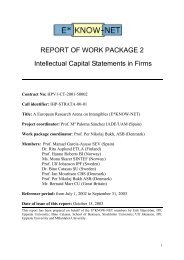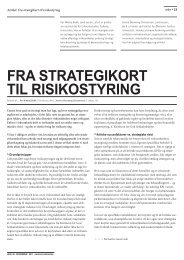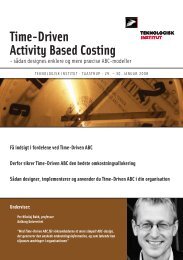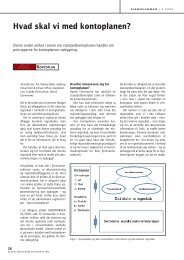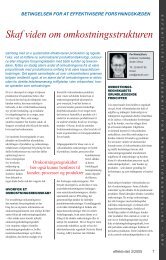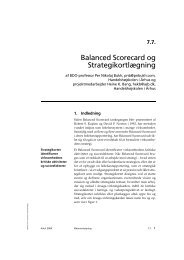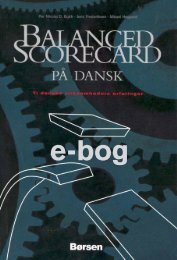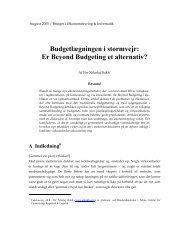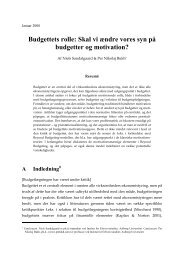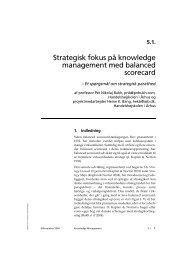guidelines for managing and reporting on intangibles (intellectual
guidelines for managing and reporting on intangibles (intellectual
guidelines for managing and reporting on intangibles (intellectual
Create successful ePaper yourself
Turn your PDF publications into a flip-book with our unique Google optimized e-Paper software.
closely linked to their ability to create value <str<strong>on</strong>g>and</str<strong>on</strong>g> believe that <strong>intellectual</strong> capital is a key<br />
part of their business process.<br />
The identificati<strong>on</strong> of <strong>intangibles</strong> singles out <str<strong>on</strong>g>and</str<strong>on</strong>g> leverages certain key assets that<br />
otherwise would have been overlooked <str<strong>on</strong>g>and</str<strong>on</strong>g> enhances the firm’s awareness about the<br />
relevance of these assets in the value creati<strong>on</strong> process. The effective management of<br />
<strong>intangibles</strong> might increase the firm’s commitment with its <strong>intellectual</strong> capital.<br />
There has been a debate over the last years about the purposes that firms may have<br />
when attempting to measure their <strong>intangibles</strong>. Some are management-related purposes,<br />
some are external purposes, i.e., to provide useful third-party in<str<strong>on</strong>g>for</str<strong>on</strong>g>mati<strong>on</strong> <strong>on</strong> the real<br />
value of the firm. However, this difference between internal <str<strong>on</strong>g>and</str<strong>on</strong>g> external use of the<br />
in<str<strong>on</strong>g>for</str<strong>on</strong>g>mati<strong>on</strong> <strong>on</strong> <strong>intangibles</strong> tends to blur since outsiders’ percepti<strong>on</strong>s of how value is<br />
created by the firm increasingly take account of internal management systems (Vickery,<br />
2000). As a result, firms must have both internal <str<strong>on</strong>g>and</str<strong>on</strong>g> external uses in mind when<br />
designing their Intellectual Capital Management systems.<br />
The model we propose as a representati<strong>on</strong> of the approach followed by companies when<br />
developing their intangible management system can be split into three n<strong>on</strong>-linear <str<strong>on</strong>g>and</str<strong>on</strong>g><br />
related phases:<br />
1. Identificati<strong>on</strong> of <strong>intangibles</strong><br />
2. Measurement<br />
3. Acti<strong>on</strong><br />
4.1. Phase 1. Identificati<strong>on</strong> of <strong>intangibles</strong><br />
The starting point must be a definiti<strong>on</strong> of the visi<strong>on</strong> of the firm, that is, a statement of<br />
the organizati<strong>on</strong>’s missi<strong>on</strong> <str<strong>on</strong>g>and</str<strong>on</strong>g> of the related strategic goals. Firms then need to identify<br />
those <strong>intangibles</strong> that are critical to their strategic objectives. Those critical <strong>intangibles</strong><br />
are the main factors, the key drivers, which c<strong>on</strong>tribute most to the value creati<strong>on</strong><br />
process. They embrace the core competencies the company possesses or needs to<br />
develop in order to attain its objectives.<br />
To obtain that in<str<strong>on</strong>g>for</str<strong>on</strong>g>mati<strong>on</strong>, the firm has to answer questi<strong>on</strong>s such as: where are we?,<br />
where do we want to go?, what are our challenges? what have we got <str<strong>on</strong>g>and</str<strong>on</strong>g> what do we<br />
need in terms of <strong>intangibles</strong>? Usually, the answers to these questi<strong>on</strong>s emerge as a result<br />
of internal discussi<strong>on</strong>s or brainstorming sessi<strong>on</strong>s.<br />
Companies are c<strong>on</strong>cerned both about the status of their intangible resources <str<strong>on</strong>g>and</str<strong>on</strong>g> about<br />
the acti<strong>on</strong>s that should be undertaken in order to maintain <str<strong>on</strong>g>and</str<strong>on</strong>g> improve those resources.<br />
On the <strong>on</strong>e h<str<strong>on</strong>g>and</str<strong>on</strong>g>, it is important not to focus <strong>on</strong>ly <strong>on</strong> those activities that might increase<br />
the level of critical <strong>intangibles</strong>, but also to c<strong>on</strong>sider those that might hamper or even<br />
diminish their intangible resources. On the other h<str<strong>on</strong>g>and</str<strong>on</strong>g>, companies must also c<strong>on</strong>sider<br />
their future strategic objectives. They need to link current intangible activities with their<br />
l<strong>on</strong>g-term strategy, which might c<strong>on</strong>tain certain objectives that are presently not<br />
c<strong>on</strong>sidered.<br />
In sum, the first step is the identificati<strong>on</strong> of the strategic objectives of the firm. Then,<br />
management should identify related intangible resources <str<strong>on</strong>g>and</str<strong>on</strong>g> define the activities that<br />
14



